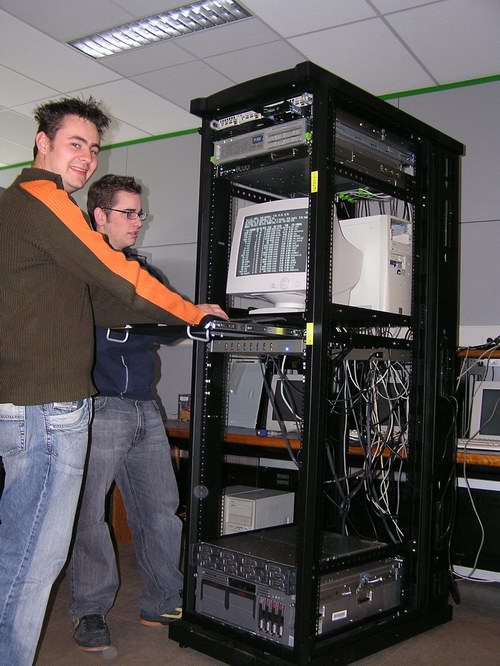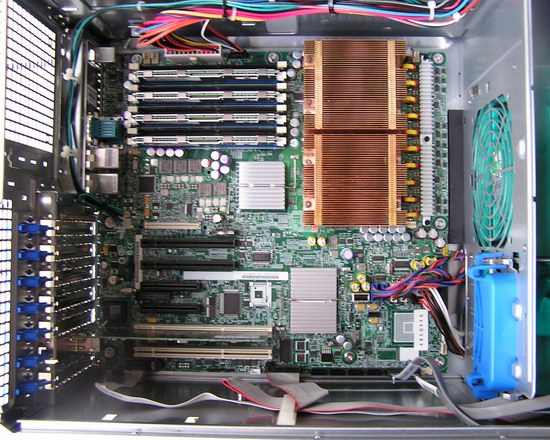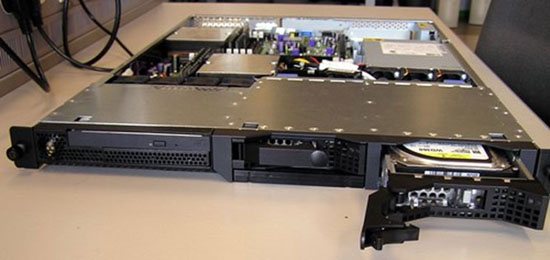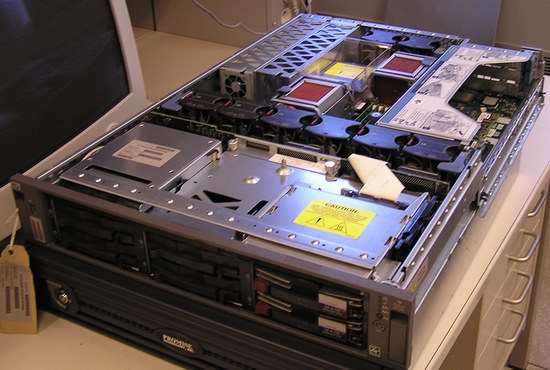Intel Woodcrest, AMD's Opteron and Sun's UltraSparc T1: Server CPU Shoot-out
by Johan De Gelas on June 7, 2006 12:00 PM EST- Posted in
- IT Computing
Words of Thanks
A lot of people gave us assistance with this project, and we like to thank them of course.
Waseem Ahmad, Intel US
Matty Bakkeren, Intel Netherlands
Trevor E. Lawless, Intel US
(www.intel.com)
Chhandomay Mandal, Sun US
Luojia Chen, Sun US
Peter A. Wilson, Sun US
(www.sun.com)
Peter Zaitsev, Elite MySQL Guru
(www.mysql.com)
Damon Muzny, AMD US
(www.amd.com)
Steve Olson, Sybase US
(www.sybase.com)
Erwin Vanluchene, HP Belgium
(www.hp.be)
Ilona van Poppel, MSI Netherlands
Ruudt Swanen, MSI Netherlands
(www.msi-computer.nl)
Alexander Goodrich, Assembler Guru
Bert Devriese, Developer of MySQL & PHP benchmark
Dieter Saeys, Gentoo/Linux support
Brecht Kets, Development of Improved Bench program
Tijl Deneut, Solaris, PostGreSQL and MySQL support
I also like to thank Lode De Geyter, manager of the University College of West-Flanders. Further information about our server research is available on our website.
Benchmark Configuration
We used Solaris 10 for the Sun T2000, as the only supported OS for the T2000 right now is Solaris 10 3/05 HW2 (and upwards). The T1 is fully binary compatibility with the existing SPARC binaries but needs this version of Solaris.
Below is a picture of our Server lab at the University College of West-Flanders. You can see Bert and Dieter standing next to our brand new rack of the server research lab.

From top to bottom, we have the Supermicro SuperServer 6014P-32, the MSI K2-102A2M, the Sun T2000, our own PIII based Linux gateway and firewall, and at the bottom, the Promise JBOD300s and the HP DL585. Yes, we still have a lot of benchmarking to do. The other Intel based machines are in towers, so you won't find them in our rack.
All benchmarking is monitored: CPU load, network and disk I/O are watched using CPU graph, top, vmstat and prstat. This way we can determine whether or not the CPU or another component is the bottleneck.
Our web server tests are performed on Apache2 2.0.55, including the mod_deflate module for gzip compression, PHP4.4.1 and Mysql 5.0.21.
Hardware Configurations
Here is the list of the different server configurations:
Sun T2000:
Sun UltraSparc T1 1 GHz, 8 cores, 32 threads
Sun Solaris 10
32 GB (16x2048 MB) Crucial DDR-2 533
NIC: 1 Gb Intel RC82540EM - Intel E1000 driver.
You can find much more information about the T1 CPU in our previous article.
Intel Server 1:
Dual Intel Xeon "Woodcrest" 3 GHz Shared 4 MB L2 cache, 1333 MHz FSB (4 cores total)

Blackford Chipset
64 bit Gentoo Kernel 2.6.15-gentoo-r7
Intel Server Board S5000
4 GB (4x1024 MB) Micron FB-DIMM Registered DDR2-533 CAS 4, ECC enabled
NIC: Dual Intel PRO/1000 Server NIC
2x Western Digital Raptor 36 GB SATA
Intel Server 2:
Dual Intel Xeon "Irwindale" 3.6 GHz 2 MB L2 cache, 800 MHz FSB - Lindenhurst
64 bit Gentoo Kernel 2.6.15-gentoo-r7
Intel Server Board SE7520AF2
8 GB (8x1024 MB) Micron Registered DDR2-400 CAS 3, ECC enabled
NIC: Dual Intel PRO/1000 Server NIC (Intel 82546GB controller)
2x Western Digital Raptor 36 GB SATA
Opteron Server 1: Dual Opteron 275 2.2 GHz 2x1MB L2 cache (4 cores total)
64 bit Gentoo Kernel 2.6.15-gentoo-r7
Solaris x86 10
MSI K8N Master2-FAR
4 GB: 4x1GB MB Crucial DDR-400 (3-3-3-6)
NIC: Broadcom BCM5721 (PCI-E)
2x Western Digital Raptor 36 GB SATA
Opteron Server 2: MSI K2-102A2M

ServerWorksHT2000 Chipset
64 bit Gentoo Kernel 2.6.15-gentoo-r7
4 GB: 4x1GB MB Crucial DDR-400 (3-3-3-6)
NIC: Broadcom BCM5721 (PCI-E)
2x Western Digital Raptor 36 GB SATA
Opteron Server 3: HP DL385

Solaris x86 10
AMD 81xx chipset
64 bit Gentoo Kernel 2.6.15-gentoo-r7
4 GB: 4x1GB MB Crucial DDR-400 (3-3-3-6)
NIC: Broadcom BCM5721 (PCI-E)
2x Seagate Cheetah 36 GB - 15000 rpm - SCSI 320 MB/s
Client Configuration: Dual Opteron 850
MSI K8T Master1-FAR
4x512 MB Infineon Registered DDR-333, ECC
NIC: Broadcom 5705
Common Software
64 bit Gentoo Kernel 2.6.15-gentoo-r7
Apache2 2.0.55 + mod_deflate module for gzip compression.
PHP4.4.1
Mysql5.0.21
A lot of people gave us assistance with this project, and we like to thank them of course.
Waseem Ahmad, Intel US
Matty Bakkeren, Intel Netherlands
Trevor E. Lawless, Intel US
(www.intel.com)
Chhandomay Mandal, Sun US
Luojia Chen, Sun US
Peter A. Wilson, Sun US
(www.sun.com)
Peter Zaitsev, Elite MySQL Guru
(www.mysql.com)
Damon Muzny, AMD US
(www.amd.com)
Steve Olson, Sybase US
(www.sybase.com)
Erwin Vanluchene, HP Belgium
(www.hp.be)
Ilona van Poppel, MSI Netherlands
Ruudt Swanen, MSI Netherlands
(www.msi-computer.nl)
Alexander Goodrich, Assembler Guru
Bert Devriese, Developer of MySQL & PHP benchmark
Dieter Saeys, Gentoo/Linux support
Brecht Kets, Development of Improved Bench program
Tijl Deneut, Solaris, PostGreSQL and MySQL support
I also like to thank Lode De Geyter, manager of the University College of West-Flanders. Further information about our server research is available on our website.
Benchmark Configuration
We used Solaris 10 for the Sun T2000, as the only supported OS for the T2000 right now is Solaris 10 3/05 HW2 (and upwards). The T1 is fully binary compatibility with the existing SPARC binaries but needs this version of Solaris.
Below is a picture of our Server lab at the University College of West-Flanders. You can see Bert and Dieter standing next to our brand new rack of the server research lab.

From top to bottom, we have the Supermicro SuperServer 6014P-32, the MSI K2-102A2M, the Sun T2000, our own PIII based Linux gateway and firewall, and at the bottom, the Promise JBOD300s and the HP DL585. Yes, we still have a lot of benchmarking to do. The other Intel based machines are in towers, so you won't find them in our rack.
All benchmarking is monitored: CPU load, network and disk I/O are watched using CPU graph, top, vmstat and prstat. This way we can determine whether or not the CPU or another component is the bottleneck.
Our web server tests are performed on Apache2 2.0.55, including the mod_deflate module for gzip compression, PHP4.4.1 and Mysql 5.0.21.
Hardware Configurations
Here is the list of the different server configurations:
Sun T2000:
Sun UltraSparc T1 1 GHz, 8 cores, 32 threads
Sun Solaris 10
32 GB (16x2048 MB) Crucial DDR-2 533
NIC: 1 Gb Intel RC82540EM - Intel E1000 driver.
You can find much more information about the T1 CPU in our previous article.
Intel Server 1:
Dual Intel Xeon "Woodcrest" 3 GHz Shared 4 MB L2 cache, 1333 MHz FSB (4 cores total)

Blackford Chipset
64 bit Gentoo Kernel 2.6.15-gentoo-r7
Intel Server Board S5000
4 GB (4x1024 MB) Micron FB-DIMM Registered DDR2-533 CAS 4, ECC enabled
NIC: Dual Intel PRO/1000 Server NIC
2x Western Digital Raptor 36 GB SATA
Intel Server 2:
Dual Intel Xeon "Irwindale" 3.6 GHz 2 MB L2 cache, 800 MHz FSB - Lindenhurst
64 bit Gentoo Kernel 2.6.15-gentoo-r7
Intel Server Board SE7520AF2
8 GB (8x1024 MB) Micron Registered DDR2-400 CAS 3, ECC enabled
NIC: Dual Intel PRO/1000 Server NIC (Intel 82546GB controller)
2x Western Digital Raptor 36 GB SATA
Opteron Server 1: Dual Opteron 275 2.2 GHz 2x1MB L2 cache (4 cores total)
64 bit Gentoo Kernel 2.6.15-gentoo-r7
Solaris x86 10
MSI K8N Master2-FAR
4 GB: 4x1GB MB Crucial DDR-400 (3-3-3-6)
NIC: Broadcom BCM5721 (PCI-E)
2x Western Digital Raptor 36 GB SATA
Opteron Server 2: MSI K2-102A2M

ServerWorksHT2000 Chipset
64 bit Gentoo Kernel 2.6.15-gentoo-r7
4 GB: 4x1GB MB Crucial DDR-400 (3-3-3-6)
NIC: Broadcom BCM5721 (PCI-E)
2x Western Digital Raptor 36 GB SATA
Opteron Server 3: HP DL385

Solaris x86 10
AMD 81xx chipset
64 bit Gentoo Kernel 2.6.15-gentoo-r7
4 GB: 4x1GB MB Crucial DDR-400 (3-3-3-6)
NIC: Broadcom BCM5721 (PCI-E)
2x Seagate Cheetah 36 GB - 15000 rpm - SCSI 320 MB/s
Client Configuration: Dual Opteron 850
MSI K8T Master1-FAR
4x512 MB Infineon Registered DDR-333, ECC
NIC: Broadcom 5705
Common Software
64 bit Gentoo Kernel 2.6.15-gentoo-r7
Apache2 2.0.55 + mod_deflate module for gzip compression.
PHP4.4.1
Mysql5.0.21










91 Comments
View All Comments
blackbrrd - Wednesday, June 7, 2006 - link
Finally Intel can give AMD some real competition in the two socket server market. This shows why Dell only wanted to go with AMD for 4S and not 2S server systems...245w vs 374w and a huge performance lead over the previous Intel generation is a huge leap for Intel.
It will be interesting to see how much these systems are going to cost:
1) is the fb-dimm's gonna be expensive?
2) is the cpu's gonna be expensive?
3) is the motherboards gonna be expensive?
For AMD neither the ram nor the motherboards are expensive, so I am curious how this goes..
If anybody thinks I am an Intel fanboy, I have bought in this sequence: intel amd intel intel, and I would have gotten and amd instead of an intel for the last computer, except I wanted a laptop ;)
JarredWalton - Wednesday, June 7, 2006 - link
For enterprise servers, price isn't usually a critical concern. You often buy what runs your company best, though of course there are plenty of corporations that basically say "Buy the fastest Dell" and leave it at that.FB-DIMMs should cost slightly more than registered DDR2, but not a huge difference. The CPUs should actually be pretty reasonably priced, at least for the standard models. (There will certainly be models with lots of L3 cache that will cost an arm and a leg, but that's a different target market.)
Motherboards for 2S/4S are always pretty expensive - especially 4S. I would guess Intel's boards will be a bit more expensive than equivalent AMD boards on average, but nothing critical. (Note the "equivalent" - comparing boards with integrated SCSI and 16 DIMM slots to boards that have 6 DIMM slots is not fair, right?)
Most companies will just get complete systems anyway, so the individual component costs are only a factor for small businesses that want to take the time to build and support their own hardware.
blackbrrd - Wednesday, June 7, 2006 - link
Registered DDR2 is dirt cheap, so if FB-DIMMs are only slightly more expensive thats really good.About compareing 6 DIMM slot and 16 DIMM slot motherboards, I agree, you can't do it. The number of banks is also important, we have a motherboard at work with 8 ranks and 6 DIMM slots, so only two of the slots can be filled with the cheapest 2gb dual rank memory. Currently 2gb single ranks modules are 50% more expensive than dual rank modules.
Which brings another question.. Does FB-DIMM have the same "problem" with rank limit in addition to slot limit? Or does the FB part take care of that?
BaronMatrix - Wednesday, June 7, 2006 - link
why are we running servers with only 4GB RAM. I have that in my desktop. Not ot nitpick but I think you shuld load up 16GB and rerun the tests. If not this is a low end test, not HPC. I saw the last Apache comparison and it seems like the benchmark is different. Opteron was winning by 200-400% in those tests. What happened?JohanAnandtech - Wednesday, June 7, 2006 - link
Feel free to send me 12 GB of FBDIMMs. And it sure isn't a HPC test, it is a server test."I saw the last Apache comparison and it seems like the benchmark is different. Opteron was winning by 200-400% in those tests. What happened? "
A new Intel architecture called "Core" was introduced :-)
BaronMatrix - Wednesday, June 7, 2006 - link
I didn't say the scores, I said the units in the benchmark. I'm not attacking you. It just stuck out in my head that the units didn't seem to be the same as the last test with Paxville. By saying HPC, I mean apps that use 16GB RAM, like Apache/Linux/Solaris. I'm not saying you purposely couldn't get 12 more GB of RAM but all things being equal 16GB would be a better config for both systems.I've been looking for that article but couldn't find it.
JohanAnandtech - Wednesday, June 7, 2006 - link
No problem. Point is your feedback is rather unclear. AFAIK, I haven't tested with Paxville. Maybe you are referring to my T2000 review, where we used a different LAMP test, as I explained in this article. In this article the LAMP server has a lot more PHP and MySQL work.http://www.anandtech.com/IT/showdoc.aspx?i=2772&am...">http://www.anandtech.com/IT/showdoc.aspx?i=2772&am...
See the first paragraph
And the 4 GB was simply a matter of the fact that Woodcrest had 4 GB of FB DIMM.
JarredWalton - Wednesday, June 7, 2006 - link
Most HPC usage models don't depend on massive amounts of RAM, but rather on data that can be broken down into massively parallel chunks. IBM's BlueGene for example only has 256MB (maybe 512MB?) of RAM per node. When I think of HPC, that's what comes to mind, not 4-way to 16-way servers.The amount of memory used in these benchmarks is reasonable, since more RAM only really matters if you have data sets that are too large to fit with the memory. Since our server data sets are (I believe) around 1-2GB, having more than 4GB of RAM won't help matters. Database servers are generally designed to having enough RAM to fit the vast majority of the database into memory, at least where possible.
If we had 10-14GB databases, we would likely get lower results (more RAM = higher latency among other things), but the fundamental differences between platforms shouldn't change by more than 10%, and probably closer to 5%. Running larger databases with less memory would alter the benchmarks to the point where they would largely be stressing the I/O of the system - meaning the HDD array. Since HDDs are so much slower than RAM (even 15K SCSI models), enterprise servers try to keep as much of the regularly accessed data in memory as possible.
As for the Paxville article, click on the "IT Computing" link at the top of the website. Paxville is the second article in that list (and it was also linked once or twice within this article). Or http://www.anandtech.com/IT/showdoc.aspx?i=2745">here's the direct link.
BaronMatrix - Wednesday, June 7, 2006 - link
Thx for the link, but the test I was looking at was Apache and showed concurrency tests. At any rate, just don't think I was attacking you. I was curious as to the change in units I noticed.MrKaz - Wednesday, June 7, 2006 - link
How much will it cost?If Conroe XE 2.9Ghz is 1000$.
Then I assume that this will cost more.
I think looks good, but it will depends a lot of the final price.
Also does that FBdimm have a premium price over the regular ones?